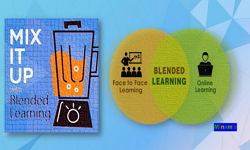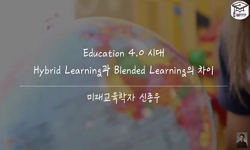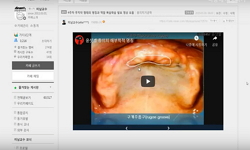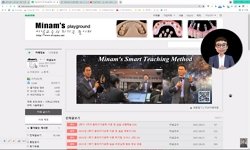The purpose of the present study is to investigate the effects of TOEIC classes using blended learning. In addition, this study’s purpose is to examine the relation between blended learning and self-directed learning readiness. For the study, the re...
http://chineseinput.net/에서 pinyin(병음)방식으로 중국어를 변환할 수 있습니다.
변환된 중국어를 복사하여 사용하시면 됩니다.
- 中文 을 입력하시려면 zhongwen을 입력하시고 space를누르시면됩니다.
- 北京 을 입력하시려면 beijing을 입력하시고 space를 누르시면 됩니다.

블렌디드 러닝을 통한 대학생들의 토익수업 효과 = The effects of TOEIC classes using blended learning for university students
한글로보기https://www.riss.kr/link?id=A101745051
- 저자
- 발행기관
- 학술지명
- 권호사항
-
발행연도
2015
-
작성언어
-
-
주제어
blended learning ; self-directed learning ; TOEIC ; 블렌디드 러닝 ; 자기주도적 학습 ; 토익
-
KDC
373
-
등재정보
KCI등재
-
자료형태
학술저널
- 발행기관 URL
-
수록면
257-281(25쪽)
-
KCI 피인용횟수
10
- 제공처
-
0
상세조회 -
0
다운로드
부가정보
다국어 초록 (Multilingual Abstract)
The purpose of the present study is to investigate the effects of TOEIC classes using blended learning. In addition, this study’s purpose is to examine the relation between blended learning and self-directed learning readiness. For the study, the research was implemented for 15 weeks with forty-two Korean university students. The students took TOEIC classes using blended learning which combines face-to-face instruction with online instruction. The results were as follows. First, TOEIC classes through blended learning were found to be effective in improving the students’ TOEIC scores. Additionally, the higher level students showed more improvement than the lower level students although there wasn’t a statistical difference between the both. Second, students’ satisfaction toward the class revealed that blended learning is suitable for a TOEIC class. The higher level students showed higher satisfaction than the lower level students. Third, there was a correlation between students’ satisfaction and ‘self-understanding’ factor in self-directed learning readiness. This result suggests that teachers should consider learners with different self-directed learning readiness to apply blended learning effectively to the class. This study shows that blended learning has a positive influence on English classes. Based on the study, some guidelines for effective English classes were suggested.
목차 (Table of Contents)
- Ⅰ. 서론
- Ⅱ. 이론적 배경
- Ⅲ. 연구 방법
- Ⅳ. 연구결과 및 논의
- Ⅴ. 결론
- Ⅰ. 서론
- Ⅱ. 이론적 배경
- Ⅲ. 연구 방법
- Ⅳ. 연구결과 및 논의
- Ⅴ. 결론
참고문헌 (Reference)
1 김지자, "초등학교 교사를 위한 자기주도적 학습 준비도 측정도구의 개발과 활용방안" 2 (2): 1-25, 1996
2 김지자, "자기주도학습의 길잡이" 교육과학사 1996
3 이웅규, "자기주도학습과 이러닝 학습환경 만족:자기조절효능감에 의한 비교분석" 한국경영과학회 31 (31): 127-143, 2006
4 김현정, "자기주도학습 준비도와 교원정보활용능력에 따른 웹 기반 훈련의 학습성취도에 관한 연구" 이화여자대학교 대학원 2004
5 양애경, "자기주도적 학습과 학업성취도간의 관계" 한국교육포럼(아시아태평양교육학회) 8 (8): 61-82, 2009
6 김지영, "인터넷을 활용한 영어 교수-학습 방법론 연구" 2 (2): 119-134, 2001
7 김희진, "이러닝 영어학습에서 페이스북을 활용한 보충학습 교수-학습 설계 및 효과성 연구" 한국영어어문교육학회 19 (19): 237-260, 2013
8 김희경, "원어민 교수자의 대학교양 영어회화 보조로서의 블렌디드 학습 사례 연구" 새한영어영문학회 47 (47): 159-182, 2005
9 김태영, "온-오프라인 결합 교양영어 수강 대학생들의 학습동기 유형과 변화" 현대영어교육학회 12 (12): 126-156, 2011
10 정화영, "수준별 학습을 지원하는 웹 기반 자기주도적 학습모형" 7 (7): 465-467, 2006
1 김지자, "초등학교 교사를 위한 자기주도적 학습 준비도 측정도구의 개발과 활용방안" 2 (2): 1-25, 1996
2 김지자, "자기주도학습의 길잡이" 교육과학사 1996
3 이웅규, "자기주도학습과 이러닝 학습환경 만족:자기조절효능감에 의한 비교분석" 한국경영과학회 31 (31): 127-143, 2006
4 김현정, "자기주도학습 준비도와 교원정보활용능력에 따른 웹 기반 훈련의 학습성취도에 관한 연구" 이화여자대학교 대학원 2004
5 양애경, "자기주도적 학습과 학업성취도간의 관계" 한국교육포럼(아시아태평양교육학회) 8 (8): 61-82, 2009
6 김지영, "인터넷을 활용한 영어 교수-학습 방법론 연구" 2 (2): 119-134, 2001
7 김희진, "이러닝 영어학습에서 페이스북을 활용한 보충학습 교수-학습 설계 및 효과성 연구" 한국영어어문교육학회 19 (19): 237-260, 2013
8 김희경, "원어민 교수자의 대학교양 영어회화 보조로서의 블렌디드 학습 사례 연구" 새한영어영문학회 47 (47): 159-182, 2005
9 김태영, "온-오프라인 결합 교양영어 수강 대학생들의 학습동기 유형과 변화" 현대영어교육학회 12 (12): 126-156, 2011
10 정화영, "수준별 학습을 지원하는 웹 기반 자기주도적 학습모형" 7 (7): 465-467, 2006
11 이현주, "블렌디드 러닝을 통한 대학생 영어학습에서의 상호작용과 자기주도적 학습의 효과" 한국교육정보미디어학회 18 (18): 1-24, 2012
12 나경희, "블렌디드 러닝 프로그램이 중학생의 영어 성취도에 미치는 효과" 한국중등영어교육학회 7 (7): 49-74, 2014
13 구양미, "대학의 혼합형 학습 환경에서 자기주도학습의 유형에 대한 분석 -실존적, 사회적 자기주도학습의 가능성" 한국교육공학회 22 (22): 161-193, 2006
14 안미리, "대학생들의 읽기 토론 수업에서 블렌디드 러닝 활용의 효과" 현대영어교육학회 11 (11): 106-133, 2010
15 金鍾伯, "自己-調整的 學習과 動機가 學業成就에 미치는 影響" 高麗大學校 大學院 1992
16 Long, H. B., "self –directed learning: Consensus and conflict" Oklahoma Research Center for Continuing Professional and Higher Education 107-122, 1991
17 Boyle, T., "Using blended learning to improve student success rates in learning to program" 28 (28): 165-178, 2003
18 Sweeney, J., "Traditional Face to Face and Web-based Tutorials : a study of University students' Perspectives on the role of tutorial participant" 9 (9): 321-323, 2004
19 Collopy, R., "To blend or not to blend : online and blended learning environments in undergraduate teacher education" 18 (18): 85-101, 2009
20 Morris, L. S., "The relationship between self-directed learning readiness and academic performance in nontraditional higher education program" The University of Oklahoma 1995
21 Graham, C. R., "The handbook of blended learning: Global perspectives, local designs" Pfeiffer 3-21, 2006
22 Bersin, J., "The blended learning book: best practices, proven methodologies, and lessons learned" Pfeiffer 2003
23 Sanprasert, N., "The application of a course management system to enhance autonomy in learning English as a foreign language" 38 : 109-123, 2010
24 Larsen, Lars Jacob Ege., "Teacher and student perspectives on a blended learning intensive English program writing course" Iowa State University 2012
25 Birch, S. H., "Social motivation: Understanding children's adjustment" Cambridge University Press 199-225, 1996
26 Bandura, A., "Self-efficacy: The exercise of control" W. H. Freeman 1997
27 Garrison, D. R., "Self-directed learning : Toward a comprehensive model" 48 (48): 18-33, 1997
28 Brockett, R. G., "Self-directed in adult learning: Perspective on theory, research and practice" Routledge 1991
29 Knowles, M. S., "Self-Directed Learning: A Guide for Learners and Teachers" Association Press 1975
30 Long, H. B, "Self-Directed Learning. Application and Research" Oklahoma Research Center for Continuing Professional and Higher Education 9-24, 1992
31 김정연, "Relationship among Motivation, Social Factors and Achievement in On-offline Blended English Writing Class" 한국영어어문교육학회 17 (17): 97-121, 2011
32 Skager, R. W., "Organizing school to encourage self-direction in learners" UNESCO Institute for Education 1978
33 Kearsley, G., "Online education: Learning and teaching in cyberspace" Wadsworth Thomson Learning 2000
34 Valiathan, P., "Learning Circuits: ASTD’s Magazine All about E-learning" 42-45, 2002
35 Fox, M., "Keeping the blended promise" 3 (3): 26-29, 2002
36 차윤정, "Implementation of instructional methods and learners’ views in online/offline business English classes." 한국멀티미디어언어교육학회 14 (14): 11-35, 2011
37 Romiszowski, A. J., "Handbook of research for educational communications and technology" Macmillan LIBRARY Reference USA 438-456, 1996
38 Lefoe, G., "Handbook of blended learning" Pfeiffer 2006
39 Guglielmino, L. M., "Development of the self-directed learning readiness scal" University of Georgia 1977
40 Oddi, L. F., "Development and validation of an instrument to identify self-directed continuing learners" 36 (36): 97-107, 1986
41 Knuth, R. A., "Designing environments for constructivist learning" Springer-VerIag 163-187, 1993
42 Vignare, K., "Blended learning: Research perspectives" Sloan Consortium 37-63, 2007
43 Shea, P., "Blended learning: Research perspectives" Sloan Consortium 19-36, 2007
44 Lopez-Perez, M. V., "Blended learning in higher education : Students’ perceptions and their relation to outcomes" 56 (56): 818-826, 2011
45 Osguthorpe, R. T., "Blended learning environments: Definitions and directions" 4 (4): 227-233, 2003
46 Graham, C. R., "Blended learning environments: A review of the research literature"
47 Driscoll, M., "Blended learning" 3 (3): 54-56, 2002
48 Long, H. B., "Associates, self-directed learning: Application and research" Oklahoma Research Center for Continuing Professional and Higher Education 189-208, 1992
49 West, R. F., "Advances in Research and Practice in Self-Directed Learning" University of Oklahoma 157-180, 1990
50 Kerres, M., "A didactical framework for the design of blended learning arrangements" 28 (28): 101-113, 2003
동일학술지(권/호) 다른 논문
-
문화적/상황적 영향에 의한 학습자와 교사의 신념이 EFL학습전략에 미치는 효과
- 한국영어어문교육학회
- 박휴버트(Pak, Hubert H)
- 2015
- KCI등재
-
- 한국영어어문교육학회
- 오희정(Oh, Hee Jeong)
- 2015
- KCI등재
-
Analysis and Evaluation of a TOEIC Textbook:Focusing on Grammar and Vocabulary Questions
- 한국영어어문교육학회
- Gil-Ja Byun
- 2015
- KCI등재
-
Smart Learning for English Learning: Exploring Learner and Learning Environmental Attributes
- 한국영어어문교육학회
- Hee-Jung Jung
- 2015
- KCI등재
분석정보
인용정보 인용지수 설명보기
학술지 이력
| 연월일 | 이력구분 | 이력상세 | 등재구분 |
|---|---|---|---|
| 2026 | 평가예정 | 재인증평가 신청대상 (재인증) | |
| 2020-01-01 | 평가 | 등재학술지 유지 (재인증) |  |
| 2017-01-01 | 평가 | 등재학술지 유지 (계속평가) |  |
| 2013-01-01 | 평가 | 등재학술지 유지 (등재유지) |  |
| 2010-01-01 | 평가 | 등재학술지 유지 (등재유지) |  |
| 2008-01-01 | 평가 | 등재학술지 유지 (등재유지) |  |
| 2005-03-22 | 학술지등록 | 한글명 : 영어어문교육외국어명 : English Language & Literature Teaching |  |
| 2005-01-01 | 평가 | 등재학술지 선정 (등재후보2차) |  |
| 2004-01-01 | 평가 | 등재후보 1차 PASS (등재후보1차) |  |
| 2002-07-01 | 평가 | 등재후보학술지 선정 (신규평가) |  |
학술지 인용정보
| 기준연도 | WOS-KCI 통합IF(2년) | KCIF(2년) | KCIF(3년) |
|---|---|---|---|
| 2016 | 0.75 | 0.75 | 0.68 |
| KCIF(4년) | KCIF(5년) | 중심성지수(3년) | 즉시성지수 |
| 0.71 | 0.66 | 1.12 | 0.12 |





 스콜라
스콜라






